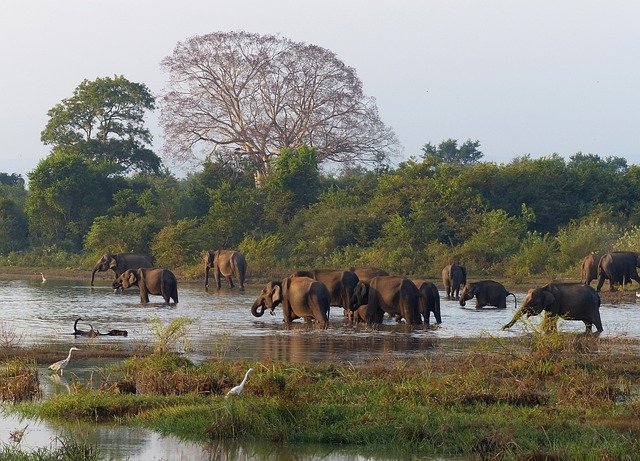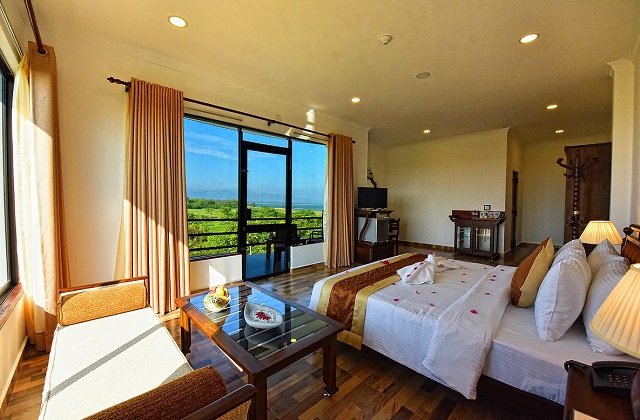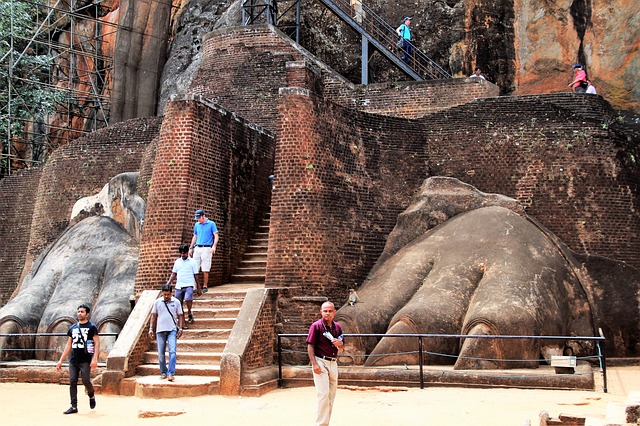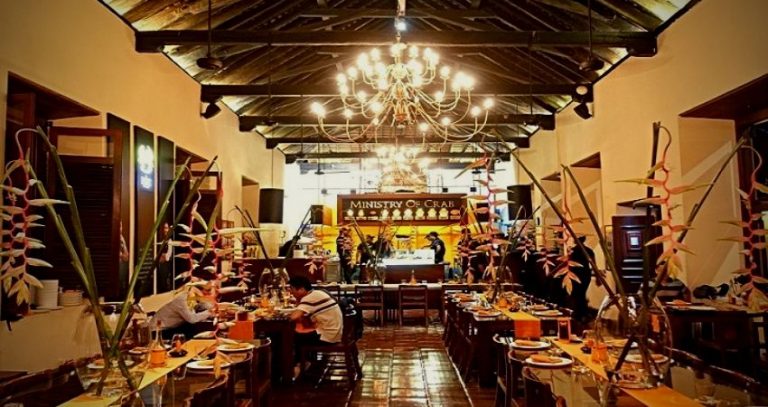Top 10 National Park To Visit In Sri Lanka
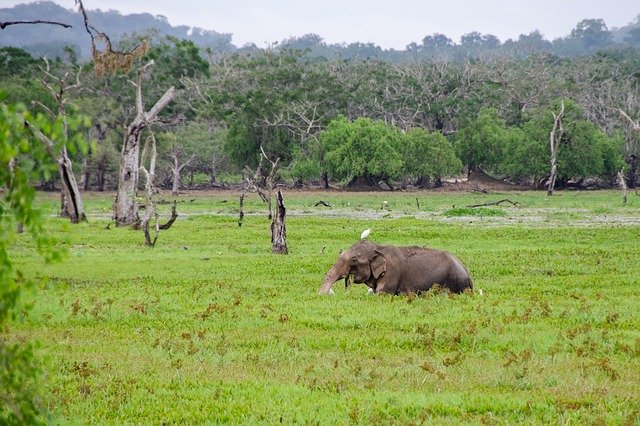
Yala National Park
Yala National Park is another renowned wildlife sanctuary located in Sri Lanka. It is situated in the southeastern part of the country, spanning across the Monaragala and Hambantota Districts. Yala National Park is the second-largest national park in Sri Lanka, covering an area of approximately 979 square kilometers (378 square miles).
The park is known for its diverse ecosystems, which include dense jungles, open grasslands, scrublands, and coastal lagoons. This variety of habitats supports a wide range of wildlife, making Yala National Park a popular destination for wildlife enthusiasts and photographers.
Yala National Park is particularly famous for its population of Sri Lankan leopards. It is believed to have one of the highest densities of leopards in the world, providing visitors with a good chance of spotting these elusive big cats. In addition to leopards, the park is home to many other animal species, including elephants, sloth bears, water buffalo, crocodiles, sambar deer, spotted deer, and a rich variety of bird species.
The park is divided into five blocks, with Block 1 being the most popular for wildlife safaris. Visitors can explore the park through guided jeep safaris, which are conducted by experienced drivers and naturalists. The safaris take visitors through the park’s different ecosystems, increasing the chances of encountering various animals and observing their natural behaviors.
Yala National Park offers both morning and afternoon safaris, each lasting approximately 3 to 4 hours. The best time to visit the park is during the dry season from February to July when the water sources within the park dry up, causing the animals to gather around the limited remaining waterholes.
Apart from its wildlife, Yala National Park also has historical significance, with the presence of ancient rock monasteries and ruins dating back to Sri Lanka’s ancient civilizations. These archaeological sites add an additional layer of interest and cultural exploration to the park.
It’s important to note that due to the park’s popularity, it can get crowded during peak tourist seasons. Therefore, it is advisable to book safaris and accommodations in advance to secure the best experience.
Yala National Park offers an incredible opportunity to witness the beauty of Sri Lanka’s wildlife, including the chance to see leopards in their natural habitat. Its diverse landscapes and rich biodiversity make it a must-visit destination for nature lovers and those seeking an adventurous wildlife experience.
Udawalawe National Park
Udawalawe National Park is a popular wildlife reserve located in the southeastern part of Sri Lanka. It is situated in the Sabaragamuwa and Uva Provinces, approximately 165 kilometers (103 miles) from Colombo, the capital city of Sri Lanka. The park covers an area of about 308 square kilometers (119 square miles) and is known for its diverse wildlife and beautiful landscapes.
Established in 1972, Udawalawe National Park was primarily created to provide a sanctuary for wild animals displaced by the construction of the Udawalawe Reservoir on the Walawe River. The park is characterized by its vast open grasslands, marshes, and extensive water bodies, making it an ideal habitat for a variety of animals.
One of the major highlights of Udawalawe National Park is its elephant population. The park is home to a large number of Asian elephants, and it is one of the best places in Sri Lanka to observe these majestic creatures in their natural habitat. Visitors can go on safaris within the park to see elephants, often in large herds, as well as other animals such as sambar deer, water buffalo, wild boar, crocodiles, and various species of birds.
Udawalawe National Park is also a haven for birdwatchers, with over 200 species of birds recorded within its boundaries. Some of the notable bird species include the Sri Lanka spurfowl, Sri Lanka grey hornbill, Malabar pied hornbill, and the brown-capped babbler.
The park offers several safari options for visitors, including jeep safaris that allow tourists to explore the park’s diverse ecosystems and spot wildlife. The best time to visit Udawalawe National Park is during the dry season, from May to September, when the animals congregate around the water sources, making it easier to spot them.
In addition to its wildlife, Udawalawe National Park also houses the Elephant Transit Home, which serves as a rehabilitation center for orphaned elephant calves. The center aims to care for and reintroduce these elephants back into the wild.
Overall, Udawalawe National Park is a must-visit destination for nature enthusiasts and wildlife lovers, offering a unique opportunity to observe Sri Lanka’s fascinating wildlife in a beautiful natural setting.
Minneriya National Park
Minneriya National Park is a well-known wildlife sanctuary located in the North Central Province of Sri Lanka. It is situated approximately 182 kilometers (113 miles) northeast of Colombo, the capital city. With an area of around 8,889 hectares (21,932 acres), Minneriya National Park is recognized for its abundant wildlife and the annual gathering of elephants known as “The Gathering.”
One of the park’s main attractions is the Minneriya Tank, a large reservoir built by King Mahasen in the 3rd century AD. The tank serves as a vital water source, attracting a diverse range of wildlife throughout the year. However, it is during the dry season, from July to October, that the park truly comes alive as hundreds of elephants congregate near the tank.
“The Gathering” of elephants in Minneriya National Park is a spectacular sight and one of the largest elephant gatherings in the world. During this period, herds of elephants from surrounding areas gather at the Minneriya Tank to feed on the lush grass and drink water. It offers a unique opportunity to witness these majestic animals in large numbers, as well as observe their social interactions and behavior.
Apart from elephants, Minneriya National Park is home to various other wildlife species. These include sambar deer, spotted deer, Sri Lankan axis deer, wild boar, sloth bears, leopards, and several species of monkeys. The park is also a birdwatcher’s paradise, with over 160 species of birds recorded, including endemic and migratory species.
To explore Minneriya National Park, visitors can take jeep safaris guided by experienced drivers and naturalists. The safaris allow visitors to navigate through the park’s grasslands, forests, and around the Minneriya Tank, providing opportunities for close encounters with wildlife and capturing stunning photographs.
It’s worth noting that Minneriya National Park is located close to other popular attractions in the Cultural Triangle of Sri Lanka, including Sigiriya Rock Fortress and the ancient city of Polonnaruwa. Many visitors combine their visit to Minneriya with these nearby cultural sites to make the most of their trip.
Minneriya National Park offers an incredible wildlife experience, especially during the elephant gathering, and showcases the natural beauty and biodiversity of Sri Lanka. It is a must-visit destination for nature enthusiasts, wildlife photographers, and anyone seeking an unforgettable encounter with elephants in their natural habitat.
Singharaja Rain Forest
Sinharaja Rainforest is a UNESCO World Heritage Site and one of the last remaining rainforests in Sri Lanka. Located in the southwestern part of the country, it is situated in the Sabaragamuwa and Southern Provinces, covering an area of approximately 11,187 hectares (27,635 acres). The name “Sinharaja” translates to “Lion Kingdom” in Sinhala, indicating its significance and grandeur.
Sinharaja Rainforest is known for its exceptional biodiversity and ecological importance. It is home to a wide variety of plant and animal species, many of which are endemic to Sri Lanka. The forest is characterized by its dense vegetation, towering trees, cascading streams, and abundant wildlife.
The rainforest is renowned for its avian population and is a haven for birdwatchers. It harbors over 160 species of birds, including 19 endemic species such as the Sri Lanka blue magpie, Sri Lanka hanging parrot, Sri Lanka frogmouth, and Sri Lanka spur fowl. The forest echoes with the melodious songs and calls of these colorful feathered inhabitants.
In addition to its avifauna, Sinharaja Rainforest is home to numerous mammals, reptiles, amphibians, and invertebrates. Some of the notable animal species found in the forest include purple-faced langurs, giant squirrels, endemic purple-faced leaf monkeys, leopards, Sri Lankan civets, and various species of snakes and frogs.
Exploring Sinharaja Rainforest offers a unique opportunity to witness the intricate ecosystem and natural beauty of a tropical rainforest. Visitors can embark on guided hikes or treks along designated trails to explore the forest and appreciate its remarkable flora and fauna. The trails lead to breathtaking viewpoints, picturesque waterfalls, and hidden corners where the forest’s secrets unfold.
It is important to note that visiting Sinharaja Rainforest requires a permit, and it is recommended to hire a knowledgeable guide to make the most of your experience and ensure minimal impact on the delicate ecosystem.
Sinharaja Rainforest stands as a conservation stronghold, preserving the rich biodiversity of Sri Lanka. Its ecological significance and natural beauty make it a must-visit destination for nature lovers, researchers, and those seeking an immersive rainforest experience.
Horton Plains National Park
Horton Plains National Park is a picturesque and biodiverse nature reserve located in the central highlands of Sri Lanka. Situated in the Nuwara Eliya District, it covers an area of approximately 3,160 hectares (7,807 acres) and is part of the Central Highlands UNESCO World Heritage Site.
Horton Plains National Park is known for its stunning landscapes, unique ecosystems, and endemic flora and fauna. It is characterized by undulating grasslands, cloud forests, rocky outcrops, and cascading waterfalls, creating a captivating and diverse environment.
One of the park’s most famous attractions is World’s End, a sheer precipice that offers breathtaking panoramic views of the surrounding valleys and tea estates. The view from this point is especially dramatic in the early morning when the mist clears, revealing the vast expanse below.
Another notable feature within the park is Baker’s Falls, a picturesque waterfall cascading down a rocky face surrounded by lush vegetation. Visitors can take a short hike to reach this scenic spot and enjoy the beauty of the cascading water.
Horton Plains National Park is also home to several endemic species, making it a hotspot for biodiversity. The park’s forests shelter many rare and threatened plants, including the Sri Lanka whistling thrush and Sri Lanka bush warbler, both of which are endemic bird species. The park is also home to sambar deer, wild boar, purple-faced langurs, and many species of reptiles and amphibians.
The most famous trail within Horton Plains is the circular trail, which is approximately 9.5 kilometers (6 miles) long and takes visitors through the park’s highlights. The trail leads to World’s End, Baker’s Falls, and other scenic spots, offering an immersive experience in the park’s unique ecosystem. The terrain can be challenging in some sections, so it is advisable to wear appropriate footwear and be prepared for varying weather conditions.
Due to its high elevation, Horton Plains National Park has a cooler climate compared to other parts of Sri Lanka. Mist and fog are common, and temperatures can drop significantly, especially in the early morning. It is advisable to bring warm clothing and protective gear, as well as sufficient water and snacks for the trek.
Horton Plains National Park offers a remarkable opportunity to witness the beauty of Sri Lanka’s highland landscapes, endemic flora and fauna, and awe-inspiring viewpoints. Its unique features and diverse ecosystems make it a must-visit destination for nature enthusiasts, hikers, and those seeking a memorable adventure in the heart of Sri Lanka.
Wilpattu National Park
Wilpattu National Park is a renowned wildlife sanctuary located in the northwestern part of Sri Lanka. Situated in the Puttalam District, it spans across an area of approximately 1,317 square kilometers (508 square miles), making it the largest national park in the country. The park is known for its diverse ecosystems, including dense forests, scrublands, grasslands, and numerous natural lakes called “villus.”
Wilpattu National Park is famous for its impressive population of leopards, making it one of the best places in Sri Lanka to spot these elusive big cats. The park is also home to other wildlife species, including elephants, sloth bears, spotted deer, sambar deer, water buffalo, crocodiles, and various species of birds.
The park’s unique feature is its system of villus, which are natural lakes that dot the landscape. These villus provide crucial water sources for wildlife, particularly during the dry season when other water bodies in the region start to dry up. The presence of these villus adds to the scenic beauty of the park and creates excellent opportunities for wildlife sightings.
Exploring Wilpattu National Park involves jeep safaris, which are conducted by experienced guides and drivers. The safaris take visitors through the park’s different habitats, offering opportunities to spot wildlife, enjoy the picturesque landscapes, and learn about the park’s rich biodiversity.
Wilpattu National Park is known for its tranquil and uncrowded atmosphere, as it attracts fewer visitors compared to some other popular national parks in Sri Lanka. This provides a more exclusive and intimate wildlife experience for those who visit.
It’s important to note that Wilpattu National Park was closed for several years due to the civil war in Sri Lanka but reopened to the public in 2010. Since then, efforts have been made to restore and protect the park’s natural habitats and wildlife.
The best time to visit Wilpattu National Park is during the dry season from February to October when the vegetation is less dense, and wildlife sightings are more frequent. However, even during the wet season, the park offers its own unique charm and opportunities to witness the lush greenery and migratory bird populations.
Wilpattu National Park presents a captivating blend of wildlife, landscapes, and cultural heritage, as it is believed to have been a sanctuary for Buddhist monks in ancient times. It is a must-visit destination for nature lovers, photographers, and those seeking a peaceful and immersive wildlife experience in Sri Lanka.
Bundala National Park
Bundala National Park is a significant wildlife sanctuary located in the southern part of Sri Lanka. It is situated in the Hambantota District, approximately 251 kilometers (156 miles) southeast of Colombo. With an area of about 6,216 hectares (15,355 acres), Bundala National Park is recognized for its rich biodiversity and importance as a Ramsar Wetland of International Importance.
The park is renowned for its extensive wetlands, lagoons, and coastal habitats, making it a haven for migratory and resident bird species. In fact, Bundala National Park is considered one of the most important birdwatching destinations in Sri Lanka. The park is home to over 200 species of birds, including both endemic and migratory species such as greater flamingos, painted storks, black-necked storks, Asian openbill storks, and a variety of waders and waterfowl.
In addition to its avian population, Bundala National Park boasts a diverse range of other wildlife. The park is home to elephants, crocodiles, sambar deer, spotted deer, wild boar, water buffalo, and various species of monkeys. It is also one of the best places in Sri Lanka to spot the endangered and elusive Indian pangolin.
Bundala National Park offers jeep safaris that allow visitors to explore its diverse habitats and observe wildlife in their natural surroundings. The park is characterized by its scenic landscapes, including salt pans, sand dunes, scrublands, and lagoons, creating a unique and picturesque environment for wildlife enthusiasts and photographers.
The best time to visit Bundala National Park is during the dry season from May to September when the water levels recede, and bird populations concentrate around the remaining water sources. However, the park is worth visiting throughout the year as different seasons bring different wildlife and bird species.
The park also offers opportunities for boat safaris along the lagoons, providing a different perspective and a chance to observe water birds and crocodiles up close.
Bundala National Park is not only a sanctuary for wildlife but also plays a crucial role in conserving and protecting the delicate coastal ecosystems and habitats. The park is involved in various conservation initiatives, including the conservation of sea turtles that nest along the park’s beaches.
With its abundant birdlife, diverse wildlife, and beautiful coastal landscapes, Bundala National Park offers a rewarding and unique experience for nature lovers and birdwatchers. It is a must-visit destination for those seeking to explore Sri Lanka’s natural wonders and witness the harmony between land and water ecosystems.
Gal Oya National Park
Gal Oya National Park is a remarkable wildlife sanctuary located in the eastern part of Sri Lanka. It is situated in the Ampara District, approximately 314 kilometers (195 miles) east of Colombo. With an area of around 25,900 hectares (64,000 acres), Gal Oya National Park is known for its untouched wilderness, scenic landscapes, and its unique boat safari experience on the Senanayake Samudraya Reservoir.
The centerpiece of Gal Oya National Park is the Senanayake Samudraya Reservoir, which is the largest reservoir in Sri Lanka. The reservoir was created by damming the Gal Oya River, and it forms a central feature of the park’s ecosystem. The boat safari on the reservoir allows visitors to explore its tranquil waters, admire the surrounding forests and islands, and observe wildlife, including swimming elephants.
Speaking of elephants, Gal Oya National Park is home to a significant population of wild elephants. It is one of the few places in Sri Lanka where visitors have the opportunity to witness elephants swimming between islands in the reservoir. The park is also home to other wildlife species, such as sloth bears, leopards, water buffalo, sambar deer, wild boar, and various bird species.
The park’s diverse habitats include evergreen forests, grasslands, and shrublands, providing a haven for flora and fauna. The rich vegetation supports a variety of birdlife, making it an excellent destination for birdwatching. Bird species that can be found in Gal Oya National Park include the rare red-faced malkoha, Sri Lanka spurfowl, Oriental darter, and the globally endangered lesser adjutant.
One of the unique experiences offered in Gal Oya National Park is the opportunity to visit the indigenous Vedda community. The Veddas are the original inhabitants of Sri Lanka, and they have a deep connection with the forest. Visitors can learn about their traditional lifestyle, cultural practices, and even participate in activities like hunting, gathering, and archery.
To explore Gal Oya National Park, jeep safaris are available, allowing visitors to traverse the park’s diverse terrain and spot wildlife. The boat safaris on the Senanayake Samudraya Reservoir provide a serene and different perspective, showcasing the park’s beauty from the water.
The best time to visit Gal Oya National Park is during the dry season from May to September when wildlife sightings are more common, and the water levels in the reservoir are lower, concentrating wildlife around remaining water sources.
Gal Oya National Park offers a unique and off-the-beaten-path experience for nature enthusiasts, wildlife lovers, and those interested in cultural heritage. Its pristine wilderness, remarkable boat safaris, and interactions with the Vedda community make it a captivating destination for an immersive wildlife and cultural adventure in Sri Lanka.
Kaudulla National Park
Kaudulla National Park is a stunning wildlife reserve located in the North Central Province of Sri Lanka. Situated in the vicinity of Habarana, it covers an area of approximately 6,900 hectares (17,000 acres). The park is known for its diverse wildlife, beautiful landscapes, and its population of wild elephants.
One of the main attractions of Kaudulla National Park is the large gathering of elephants that takes place during the dry season. As water sources in surrounding areas diminish, herds of elephants migrate to the Kaudulla Reservoir within the park to quench their thirst and graze on the lush grasslands. It is a remarkable sight to witness these majestic creatures in their natural habitat.
Apart from elephants, Kaudulla National Park is also home to various other wildlife species. The park is inhabited by sambar deer, spotted deer, wild boar, Sri Lankan axis deer, sloth bears, leopards, and several species of monkeys, including the endemic toque macaque. Birdwatchers will also appreciate the park’s avian diversity, as it hosts over 160 species of birds, including migratory species such as the spot-billed pelican and the painted stork.
Exploring Kaudulla National Park is typically done through jeep safaris, which allow visitors to navigate through the park’s trails and witness wildlife encounters. The safaris are usually conducted in the early morning or late afternoon, as these times offer better opportunities for wildlife sightings.
The best time to visit Kaudulla National Park is during the dry season from May to September when the water levels in the reservoir recede, revealing vast expanses of grasslands and attracting large gatherings of elephants. However, the park is open year-round, and each season brings its own charm and wildlife experiences.
Kaudulla National Park offers a more off-the-beaten-path experience compared to some of the more popular national parks in Sri Lanka, providing visitors with a quieter and more intimate wildlife encounter. The park’s scenic landscapes, abundance of wildlife, and the chance to witness the mesmerizing sight of elephants make it a captivating destination for nature enthusiasts and wildlife lovers.
It’s important to note that like other national parks in Sri Lanka, visiting Kaudulla National Park requires a permit and is best done with the assistance of an experienced guide to ensure a safe and responsible wildlife experience.
Wasgamuwa National Park
Wasgamuwa National Park is a scenic wildlife sanctuary located in the Matale and Polonnaruwa Districts of Sri Lanka. Situated in the central part of the country, it spans across an area of approximately 36,948 hectares (91,279 acres). The park is known for its diverse ecosystems, abundant wildlife, and beautiful landscapes.
Wasgamuwa National Park is characterized by its mix of dry evergreen forests, grasslands, and wetlands. The park is traversed by the Mahaweli River, which provides water and sustenance to the flora and fauna within the park. The varied habitats support a wide range of wildlife species, making it an important conservation area in Sri Lanka.
The park is home to a significant population of elephants, and sightings of these majestic creatures are quite common. Other wildlife species found in Wasgamuwa National Park include sambar deer, spotted deer, water buffalo, Sri Lankan axis deer, wild boar, leopards, sloth bears, and several species of monkeys. Bird enthusiasts will also enjoy the park, as it is home to over 140 species of birds, including endemic and migratory species.
Exploring Wasgamuwa National Park is usually done through jeep safaris, which allow visitors to navigate through the park’s trails and observe wildlife in their natural habitat. The park offers opportunities for both morning and evening safaris, each providing a different perspective and wildlife activity.
The best time to visit Wasgamuwa National Park is during the dry season from May to September, when water sources become scarce, and wildlife tends to congregate around the remaining waterholes. During this time, the chances of spotting wildlife, including elephants, are higher.
Apart from wildlife watching, visitors to Wasgamuwa National Park can also enjoy the picturesque landscapes and engage in nature photography. The park’s scenic beauty, with its serene lakes, rolling hills, and lush forests, creates a tranquil and immersive experience.
Wasgamuwa National Park is less crowded compared to some of the more popular national parks in Sri Lanka, allowing visitors to enjoy a more serene and secluded wildlife encounter. It offers an opportunity to connect with nature, witness the wonders of Sri Lanka’s wildlife, and appreciate the importance of conservation efforts.
Overall, Wasgamuwa National Park is a must-visit destination for nature enthusiasts, wildlife lovers, and anyone seeking an authentic wildlife experience in the heart of Sri Lanka.


